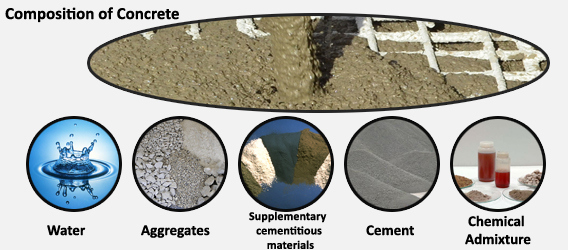How is Concrete Made
How is Concrete Built
Concrete is the most used building material on earth, it was the building block of the Roman Empire, today is the basis of sky defying skyscrapers. The raw ingredients that create this magic formula can be found on nearly every country on earth. Yet how these simple components are mixed together can make the difference between tragedy. From the ordinary to the extraordinary concrete has paved the way for innovation and lay the foundation for the world’s organization.
It starts as liquid but when it dries it becomes stone hard. This amazing metamorphosis has earned concrete the nickname “Liquid Rock”. It has served as a cornerstone of engineering for centuries and it’s a highly-priced tool of construction for a reason.
We see it every day, we walk and clime on it, and take it for granted. It is everywhere and has an almost unlimited potential. It can take on any shape as the backbone of the world’s construction. Highways, bridges, tunnels, mega dams and the tallest skyscrapers on earth are built with concrete.
How does it do it? The basic formula for concrete is sand, crushed rock (aggregate) water and at the heart of the mix cement. Cement is the gray powder material that acts as a glue to stick all the concrete together. Covers in coats all the gravel, the sand and the rocks as a way of glueing and binding everything together. To make cement you need limestone, clay and other elements like iron. These ingredients are crushed and combined into a powder that it is poured into a kiln. A massive cylindrical spinning kiln heats the mixture to a temperature of 2700 degrees Fahrenheit. The mixture becomes partially molted forming a new marble size component called Clinker. Once cooled, machines grind clinker into the refined powder that we know as cement. Cement binds everything together when added to sand, water and crushed rock. The cement reacts linking the raw elements into a one powerful whole. Water is the key, when cements reacts to the water it goes a transformation called hydration. During this reation a node forms onto the surface of each cement particles, it expands and grows linking with other nodes, it sticks to the crushed rock and sand in the mix. As it solidifies it forms concrete.
This basic process hasn’t changed in over a century.
Creating concrete is no simple matter, creating the right recipe requires precision and flawless preparation. It is a synergy of ingredients and time. Making concrete can be compared to making a cake, there are many different recipes for cakes to achieve different colors, different flavors, different textures and there are also many ways in which you can make a cake wrong is you don’t follow directions. In the same way, getting the right recipe for concrete is key because the consequences of a flawed mix can deadly.
The firsts to start using concrete where the Romans and they invented the word “concrete” which comes from the Latin “Concretus” which means grown together or compounded. Roman concrete contains the basic elements of sand, water and crushed rock, but volcanic ash from the hills of Pozole Italy transformed the material. This volcanic ash proved to be an excellent binding agent that gave ancient Rome a very powerful concrete that allowed the Romans to craft an empire from the ground up. Today, the Roman Pantheon still stands as a unique testament of the power of ancient Roman concrete. It’s been standing for 1,800 years and it’s the only building in continuous use. It is the larges surviving dome of the ancient world.
Concrete has been a key ingredient in the construction of our civilization, it has been a fundamental part of our architectural path and is now paving the road for our future. Scientist are developing new formulas to make it stronger more environmentally friendly and make it capable of doing things we never thought possible.
New technologies have the potential to change the way of how concrete looks, once considered cold and inpersonable, these new forms of concrete are transforming the material. What started off as the most basic of materials is now at the cutting edge of building and design. The future for concrete is virtually limitless. If concrete is anything it is a material that continuously reinvents itself. Concrete continuous to adapt to the challenges of our world and is laying the foundation for our future.


Sorry, the comment form is closed at this time.